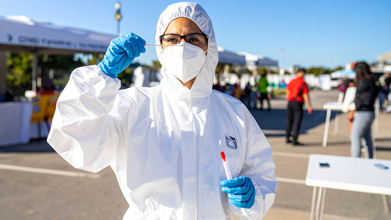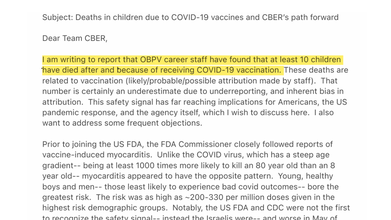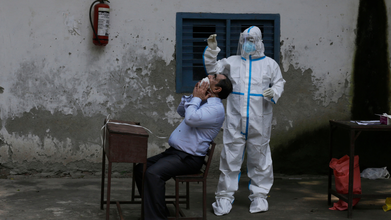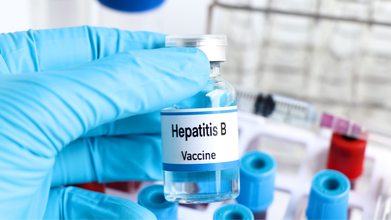- Health Conditions A-Z
- Health & Wellness
- Nutrition
- Fitness
- Health News
- Ayurveda
- Videos
- Medicine A-Z
- Parenting
10 Odd Signs Of Stress That You Thought You Knew But Don't

Image Credit: Canva
Stress is an inevitable part of life, but its consequences are not just mood swings and mental fatigue. Continual stress makes people produce extra cortisol, a hormone that has a critical role in adapting to short-term challenges, but chronically in high quantities it tends to cause harm to the body causing lots of physical and mental disorders.
The adrenal glands produce cortisol, which helps the body control its "fight, flight, or freeze" response. Cortisol temporarily adjusts blood sugar levels, maintains blood pressure, and assists the immune system, among other functions, in short spurts. But when stress persists, cortisol remains high, and necessary functions of the body are interfered with and rendered more susceptible to disease.
According to one survey conducted by the American Psychological Association, stress negatively affects a third of Americans' physical health. Concerns are reinforced by research where studies have shown 80% of primary care visits are stress-related.
But why does stress have such a profound impact? Elevated cortisol limits the immune system's ability to fight infections, disrupts hormonal balance, and triggers inflammation. Over time, these changes can lead to serious health complications.
Signs That High Cortisol Is Stressing Your Body
Persistent Eye Twitches
Do you have involuntary eye spasms? These harmless but annoying twitches often indicate elevated cortisol. The tiny muscles around the eyes are extremely sensitive to stress, contracting or spasming because of cortisol's stimulant-like effects.
Skin Breakouts and Sensitivity
Your skin often reflects what is going on inside your body, and chronic stress can cause inflammatory skin conditions. Elevated cortisol levels stimulate oil production, which exacerbates acne. It also slows down the healing process, worsens conditions like eczema, and contributes to general irritation of the skin.
Frequent Bloating and Digestive Issues
It also interferes with the body's balance of salt and water, which causes fluid retention and bloating. Excess cortisol also slows down blood flow to the digestive system, which further weakens gut bacteria and causes poor digestion, excess gas, and abdominal discomfort.
Weight Fluctuations
High cortisol stimulates the production of insulin, which can cause blood sugar to drop, making people want to eat sugary, high-fat foods. For many, this becomes an excuse to stress-eat and gain weight. For others, the opposite is true: their appetite disappears under stress, causing them to lose weight.
Unexplained Bruising
If you’re noticing random bruises, elevated cortisol could be the culprit. This hormone weakens skin proteins and the walls of small blood vessels, making your skin more fragile and prone to damage.
Cold Symptoms That Won’t Go Away
Do you feel rundown or experience muscle aches, fatigue, or upset stomach regularly? Elevated cortisol mimics cold-like symptoms. Long-term stress also weakens the immune system, making you more susceptible to infections.
Also Read: Stressed At Work? Your Sleep Might Be Paying The Price, New Study Shows
Vision Problems
Chronic stress can damage your eyesight. Elevated cortisol disrupts blood flow to the eyes, increases eye pressure, and raises the risk of glaucoma. Symptoms like dry eyes, blurred vision, and light sensitivity are also common.
Irregular Menstrual Cycles
Irregular Menstrual Cycles that disrupt the menstrual period. In females, this leads to hormonal distress causing irregular or missed periods. Over time, it may also disturb fertility.
Tinnitus or Persistent Ringing in the Ears
If you hear ringing, buzzing, or hissing sounds without an apparent source, stress might be the culprit. Cortisol affects the auditory system by interfering with blood flow and nerve function and could be the trigger for tinnitus.
Increased Inflammation and Chronic Disease
Increased levels of cortisol contribute to inflammation that can exacerbate conditions such as arthritis and promote the development of heart disease. Chronic inflammation is also associated with mental health conditions, including anxiety and depression.
Long-term Consequences of Increased Cortisol
Left unchecked, high cortisol levels can lead to more than just short-term discomfort. Chronic stress has been associated with serious conditions such as heart disease, psychiatric disorders, and metabolic syndromes. A 2013 study published in JAMA Internal Medicine underlined the link between stress and physical health, with recent research in Neurobiology of Stres supporting these findings.
Ways Managing Stress and Cortisol Levels
Managing stress and cortisol levels is essential for maintaining overall health. One effective approach is practicing mindfulness through meditation or yoga, which helps lower cortisol by calming the mind and promoting relaxation. Regular physical exercise, especially aerobic activities, helps reduce stress hormones and boosts endorphins. Prioritizing sleep is crucial, as lack of rest can increase cortisol levels; aim for 7-9 hours per night.
Another remedy is an overall balanced diet full of anti-inflammatory foods like fruits, vegetables, and whole grains that could manage cortisol production. Finally, it would prevent burnout and chronic stress if proper boundaries were set at work and in personal life.
Leaked FDA Memo Sparks Fierce Debate Over Rare Vaccine-Linked Child Deaths

Credits: Canva
After the Thanksgiving, on Friday, the Food and Drug Administration (FDA)'s top vaccine regulator, Vinay Prasad made a clam that shocked the public-health established. "For the first time, the US FDA will acknowledge that COVID-19 vaccines have killed American children," he wrote in a leaked email to his staff, as reported by The Atlantic and The Washington Post.

The agency has identified that at least 10 children died after getting COVID shots.
The email has been perceived by physicians as a "threat". A response from 12 former FDA commissioners, published in The New England Journal of Medicine on Wednesday, called Prasad's memo "a threat to evidence-based vaccine policy and public health security". All of the potential vaccine related deaths reported to government were already reviewed by the agency's staff, and had reached "different conclusions", wrote the former commissioners.
Elsewhere, doctors and scientists have declared that there are no evidence that links COVID-19 vaccines to deaths in children. The commissioners have claimed that in an attempt to deliberately bring evidence, Prasad and his colleagues had engaged in an "evidence-manufacturing mission", a "dumpster dive" for shoddy data, or worse, a campaign of lying.
Prasad is one of several public health officials who, under Robert F. Kennedy Jr.’s leadership, have been steadily chipping away at public trust in vaccines. So far, he has not provided evidence to back his claims, and his estimate of vaccine-related deaths may be exaggerated. The memo’s intense language and focus on political complaints also cast doubt on his assertions.
However, something that cannot be ignored is that fact that his memo may have provoked people to deny even the possibility of COVID-vaccine-related deaths. The Atlantic notes that "the idea that mRNA-based shots have, tragically, killed a very small number of children is not far-fetched." The article written by Benjamin Mazer, a physician who specializes in pathology and laboratory, notes that the this does not imply a "catastrophic threat to public health" as tens of millions of doses of the same vaccines have saved young people.
Understanding the Debate Of Vaccine-Linked Deaths
Public-health experts agree that COVID vaccines, like all medical treatments, can cause side effects. Myocarditis, a rare heart inflammation seen mostly in adolescent boys and young men after mRNA shots, remains the most discussed risk. Although usually mild and far less severe than virus-induced myocarditis, a few deaths have been documented worldwide, including isolated cases in the U.S., South Korea, and two American teenagers described in a peer-reviewed report.
These findings fuel ongoing debate about whether extremely rare vaccine-related deaths are being overlooked. Some scientists, including Paul Offit and Michael Osterholm, say the evidence does not prove the vaccines caused these deaths, noting that population-level studies show no rise in mortality after vaccination. Others argue that well-investigated autopsy-confirmed cases should be taken seriously rather than dismissed outright.
Experts such as Krutika Kuppalli, as cited by Mazer, emphasize that even if deaths occur, they are so uncommon they do not appear statistically, while the benefits, significantly reduced COVID mortality, are unmistakable. However, individual cases still raise questions on health authorities and the stricter standards of proofs they have applied when vaccines were involved to create a room for skepticism.
The concern is that rare side effects of vaccines could go undiscovered and not that vaccinations are inherently harmful.
This ONE Key Symptom Will Help You Differentiate Flu From COVID, According To Doctor

Credits: iStock
Are you down with fever? Are your symptoms also a little less common from an ordinary cold? Are you also confused between flu and COVID? Then knowing this one symptom could help you set flu apart from COVID. Dr Rupa Parmar, a GP and medical director at Midland Health tells The Mirror, that shortness of breath could be a key symptom that could differentiate between the two.
Dr Parmar highlights that it is a key indicator for COVID. "Shortness of breath is rare in both a cold and the flu, but as COVID more so affects the lungs due to inflammation, it is a common symptom."
The NHS website supports her advice, noting that breathlessness is a symptom more often tied to Covid, not the flu or a common cold. This kind of breathing difficulty is usually associated with infections like Covid or respiratory syncytial virus (RSV).
What Else Could Help You Know If You Have A COVID or Flu?
The nature of your cough could also help you understand different ailments. Dr Parmar said that a cold would produce a mild cough, whereas a flu cough could be more dry. However, with covid, "a cough will be dry and continuous, and many people will cough for more than an hour or have three or more coughing episodes within a day."
If one has lost their sense of smell or taste, then the chances are, this could be COVID. However, this symptom is also present in cold or in a flu.
For people who have Covid, the NHS advises staying home and avoiding contact with others if they or their children have symptoms and either develop a high temperature or feel too unwell to work, attend school, manage childcare, or carry out daily activities. If you are unsure about the cause, it is important to speak with a doctor.
Dr Parmar emphasized: "after all, it is always better to be safe than sorry when it comes to health."
What Is Flu?
The flu is a common respiratory illness that happen from the influenza virus. The common flu symptoms are:
- Fever
- Sore Throat
- Runny Nose
- Fatigue
- Body Aches
- Cough
- Headaches
What Is COVID-19?
As per the US Centers for Disease Control and Prevention (CDC), COVID-19 is a respiratory illness caused by the coronavirus. The common symptoms include:
- Fever
- Cough
- Fatigue
- Headache
- Nausea
- Sore Throat
- Runny Nose
- Loss of smell or taste
COVID-19 could also have some long-lasting symptoms unlike flu or cold, that could seem unrelated to the original infection.
As per the Ohio State University, the most recent COVID variant is XFG or the Stratus variant. Another new variant that causes the 'razor blade' like sore throat is Nimbus.
The symptoms of this new variant includes:
- Congestion
- Cough
- Fever
- Headache
- Sore throat
- Muscle Aches
'Razor blade' Throat
NB.1.8.1 or the Nimbus variant is a subvariant of Omicron, which is a dominant COVID variant since late 2021. Omicron variants tend to cause more throat problems than the other variants seen earlier.
The COVID virus binds to ACE2 receptors. According to WebMD, the cells in your nose and throat contain more ACE2 receptors than those deeper in the lungs, which makes them easier targets for Omicron variants. Once the virus attaches to these receptors in the upper airway, your immune system begins to respond.
As CDC Reconsiders Longstanding Hepatitis B Vaccines For Newborns, We Fact Checked The Claims Made By The Panel

Credits: Canva
Ever since the Trump administration has come to power, sentiments against vaccines have gone up. Many vaccine critiques have been handpicked by the anti-vaxxer HHS Secretary RFK Jr. as health officials. So it is no surprise that now the Centers for Disease Control and Prevention's Advisory Committee on Immunization Practices (ACIP) is now recommending that mothers who test negative for hepatitis B should discuss the need for the vaccine with their doctors. If parents choose to delay the birth dose, the first shot should be given at no earlier than two months of age. This is dropping the longstanding hepatitis B vaccine guideline that stated that every newborn receive the first dose of the hepatitis B vaccine shortly after birth. This recommendation, in place since 1991, was reversed on December 5 after a key CDC advisory committee voted to change the policy.
This committee was appointed by Health and Human Services Secretary Robert F. Kennedy Jr., who dismissed all 17 previous members earlier this year. The shift in policy has triggered wide debate, especially in the medical community, because it overturns one of the longest standing infant vaccination guidelines in the United States.
Below are some of the claims made by the panel, both sides, who debated the vaccine's need or unimportance for all infants.
Hidden Hepatitis B Infections Make Risk Hard to Judge
Claim: Several ACIP members questioned whether babies considered “low risk” truly need a hepatitis B shot at birth. But hepatitis B is not always easy to detect or trace.
The virus spreads through bodily fluids such as blood, semen and vaginal fluids. It is also extremely resilient and can survive on surfaces for up to a week. Even tiny amounts of dried blood from everyday items like razors, toothbrushes or nail clippers can carry the virus.
Hepatitis B often has no symptoms for years. The CDC estimates that 640,000 adults in the United States live with chronic hepatitis B, and half do not know they are infected. This means that even if a mother tests negative during pregnancy, her newborn can still be exposed through family members or other caretakers. Before universal birth-dose vaccination began, only half of infected children under age ten had contracted the virus from their mothers at birth.
Because so many people are unaware of their infections, determining true risk is complicated.
The Vaccine Protects the Most Vulnerable: Newborns
Claim: Some committee members suggested that vaccinating all newborns mainly protects adults or others at higher risk.
That claim is misleading. The primary purpose of giving the shot at birth is to protect infants, who face the most severe long-term consequences of infection.
Hepatitis B attacks the liver. If an infant becomes infected, there is a very high chance the disease will progress into a chronic lifelong condition. About a quarter of those children eventually die prematurely from liver failure or liver cancer. While treatments exist to reduce complications, there is no cure.
Dr. James Campbell, a pediatric infectious disease specialist at the University of Maryland, reminded the committee that the vaccine strategy transformed public health outcomes. “We used to have 18,000 or 20,000 kids born with this every year, and a quarter of them would go on to develop liver cancer. We now have almost none,” he said.
Falling Infection Rates Show Vaccines Worked
Claim: Hepatitis B infections fell sharply after the birth-dose recommendation took effect. Before vaccination became routine, up to 300,000 Americans were infected annually. About 20,000 of those were children.
Today, total annual cases have dropped to around 14,000. Among people under 19, chronic infections have reached extremely low levels. In 2022, the CDC documented only 252 new cases in this age group.
ACIP member Dr. H. Cody Meissner, who voted against changing the policy, argued that declining numbers do not justify easing precautions. “It is a mistake to say that because we are not seeing much disease, we can change the schedule,” he said. “If we do, hepatitis B infections will come back.”
The United States Is Not an Outlier
Claim: Some committee members compared U.S. policy to countries such as Denmark, which does not vaccinate all newborns.
However, the United States is far from alone in recommending a universal birth-dose. According to CDC data from September 2025, 116 out of 194 World Health Organization member countries recommend hepatitis B vaccination at birth.
Denmark does not include hepatitis B in its standard childhood schedule, but it has a centralized national health system, higher prenatal screening rates and less fragmented medical records. The United States lacks these structural advantages, which makes relying solely on maternal testing more challenging.
© 2024 Bennett, Coleman & Company Limited

